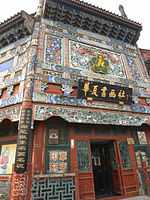Liulichang

The Liulichang (simplified Chinese: 琉璃厂; traditional Chinese: 琉璃廠; pinyin: Liúlíchǎng) is a famous district in down-town Beijing that is known for a series of traditional Chinese stone dwellings housing selling various craftwork, artistry, and antiques. It is one of Beijing's traditional old quarters.
History

Its name "liulichang" came from during the time of Ming Dynasty when a renowned colored glaze factory (Liuli Chang in Chinese) was in production in the street, which made glazed tiles for the palaces, temples and residences of the officials.[1]
According to local legend, during the Ming and Qing era, Liulichang was a favorite haunt for scholars, painters and calligraphers who gathered there to write, compile and purchase books, as well as to paint and compose poetry, and by the Kangxi period (1661-1722), Liulichang had become one of the most flourishing cultural centers in all of Beijing.[2]
Renovations
Large scale renovations in modern time have transformed this place into an antique market that resembles a Chinese village. The many shops located on the street are filled with a variety of Chinese folk arts such paintings, calligraphy, pottery, carpets, vases, books, scrolls and chops.
Today the street is a mixture of state-run and privately owned shops and customers are recommended by shop owners to bargain before making purchases. There are also traditional teahouses and wineshops, as well as many restaurants.[3]
It is a popular destination for tourists who wish to experience the commercial aspect of popular Chinese folk artwork in Beijing without the bustling traffic.
Notes
External links
Coordinates: 39°53′42.87″N 116°23′10.92″E / 39.8952417°N 116.3863667°E